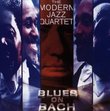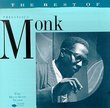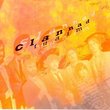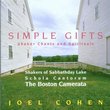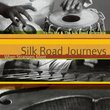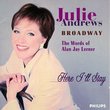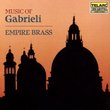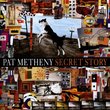| All Artists: Richard Einhorn, Ronald Hoogeveen, Steven Mercurio, Anonymous 4, Netherlands Radio Choir, Netherlands Radio Philharmonic Orchestra, Susan Narucki, Frank Hameleers, Johanna Rose, Marsha Genensky, Ruth Cunningham, Susan Hellauer Title: Richard Einhorn: Voices Of Light Members Wishing: 0 Total Copies: 2 Label: Sony Release Date: 10/24/1995 Genre: Classical Styles: Opera & Classical Vocal, Symphonies Number of Discs: 1 SwapaCD Credits: 1 UPC: 074646200629 |
Search - Richard Einhorn, Ronald Hoogeveen, Steven Mercurio :: Richard Einhorn: Voices Of Light
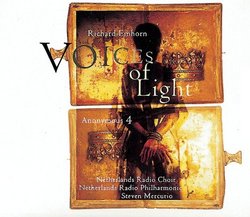 | Richard Einhorn, Ronald Hoogeveen, Steven Mercurio Richard Einhorn: Voices Of Light Genre: Classical
Voices of Light, inspired by the classic French silent film "The Passion of Joan of Arc," works as a cinematic accompaniment, but it's not movie music. Influenced by minimalism and the likes of Gorecki and Part, Einhorn'... more » ![header=[] body=[This CD is available to be requested as disc only.]](/images/attributes/disc.png?v=15401716) ![header=[] body=[This CD is available to be requested with the disc and back insert.]](/images/attributes/disc_back.png?v=15401716) ![header=[] body=[This CD is available to be requested with the disc and front insert.]](/images/attributes/disc_front.png?v=15401716) ![header=[] body=[This CD is available to be requested with the disc, front and back inserts.]](/images/attributes/disc_front_back.png?v=15401716) |
Larger Image |
CD DetailsSynopsis
Amazon.com Voices of Light, inspired by the classic French silent film "The Passion of Joan of Arc," works as a cinematic accompaniment, but it's not movie music. Influenced by minimalism and the likes of Gorecki and Part, Einhorn's music is tonal and accessible. The texts--in Latin and antique French--are from the Bible, and from writings by (mostly) medieval women, including Joan of Arc herself. Joan is represented by the reliably intelligent and well-tuned Anonymous 4 (Ruth Cunningham, Marsha Genensky, Susan Hellauer and Johanna Rose); soprano Susan Narucki sings her often high-flying lines with beauty and clarity. --Sarah Bryan Miller Similarly Requested CDs
|
CD ReviewsI'm normally a pretty jaded guy when... Bob Zeidler | Charlton, MA United States | 02/26/2003 (5 out of 5 stars) "...someone jumps up and down, telling me, "Bob, ya GOTTA HEAR this!" Well, truthfully, my initial exposure to Richard Einhorn's "Voices of Light" came about in a more subtle - and pleasurable - way. It was provided to me by a friend who had no way to anticipate my reaction. In a phrase, I was overwhelmed by the initial experience. And I continue to be, despite now having listened to this work several times, both for enjoyment and for finding words to describe it to Amazon readers. A few preliminaries first, though. This music was written firstly to provide a "live" cinematic score to accompany the screening of Carl Dreyer's classic - and legendary - 1928 silent film, "The Passion of Joan of Arc" (long thought lost until a complete, serviceable print turned up in Norway in 1981), and secondly to be performed on its own. Einhorn, inspired by the rediscovered film, composed "Voices of Light" to provide a fitting piece of music. Since its premiere in this form in 1995, it has had over 100 major "screenings" using at least some of the forces in this recording, with many additional screenings scheduled out into the future. A full-featured DVD of the film, with this music, is available elsewhere at Amazon.com. I can only comment on the music, since (for reasons that escape me), I have managed to totally miss the boat on these 100+ screenings/performances. And what music it is! Something like this comes along all too seldom. (In the recent past, I can think of only three newly-written works - all of them spiritual in their own ways - which have affected me so: Henryk Gorécki's "Symphony of Sorrowful Songs," Arvo Pärt's "Passio," and Morton Lauridsen's "Lux Aeterna.") Einhorn seems to have figuratively "come out of nowhere" with a fully-developed work that is both masterful and accessible. Cast as an oratorio for voices, strings (including a featured viola da gamba for providing the medieval sound Einhorn strived for), a small complement of woodwinds (pairs of flutes and oboes), as well as an "in-the-field" recording of the bell in the village church at which Joan worshipped, it is very moving while using rather simple musical and textual materials, often in an eclectic - yet original - way. The dramatic action is paced by the Dreyer film. Not "the story of Joan of Arc," it covers only her heresy trial and the subsequent events leading up to her being burned at the stake, with a brief epilogue excerpted from one of her letters. (Amazingly, her letters, at least in part, and the heresy trial transcripts have survived to this day!) Other texts used by Einhorn, besides those traceable to Joan and her inquisitors, are from Biblical sources and from medieval mystical and misogynistic writers, some of whom (such as Hildegard von Bingen) predate Joan by centuries yet who wrote almost as if in anticipation of just such a misogynistic heresy trial. The music alternates between medieval plainchant and early polyphony on the one hand, to represent Joan, and modern minimalism and neoromanticism on the other, to represent her inquisitors and observers. In a masterstroke of casting that works on multiple levels, Einhorn assigned Joan's voice to the remarkable early-music quartet Anonymous 4: Their style and control of early-music temperament is perfect for evoking this period, there is never any confusion as to when we are listening to Joan's words, and - as noted by Einhorn in his detailed booklet notes - Joan "heard voices," so it seemed appropriate for him to use "voices" rather than "voice" to represent her more directly. And the period is evoked yet better by having the viola da gamba accompany Anonymous 4 in several of the "Joan" sections. (Personally, I found the gambist to be somewhat of a "weak link" and that a better gambist could have been employed. But this is a small nit to pick.) Elsewhere, the dramatic action is carried by the chorus and four vocal soloists, first among equals the remarkable Susan Narucki (surely the proper heir to the legacy of contemporary music singing established earlier by Phyllis Curtin and Jan DeGaetani). The "sound world," when not medieval, is largely of minimalistic style - both mystical minimalism similar to Arvo Pärt's and a more thoroughly western minimalism that at times suggests Carl Orff (but without his usual percussive effects) and Philip Glass. Harmonically, the non-medieval sections can be quite "neoromantic" at times, yet not at all inappropriate in terms of musical continuity. There is even one section which reminded me of the echt-Baroque writings of Karl Jenkins, he of "Diamond Music" fame. But enough of "micro-analysis": The music hangs together very well, and fully supports the dramatic action. There is a logical dramatic and musical "pivot" to the work that easily separates the rather static trial sections from the much more dramatic concluding sections. It is Joan's "Abjuration" (in which she recants her confession of heresy), followed by "Karitas" (Love), based on a text from Hidegard von Bingen and sung glowingly by Ms. Narucki. "Karitas" leads directly into "Anima" (Spirit), and then one becomes swept away as the dramatic action proceeds to the actual burning, culminating in "The Fire of the Dove" (the most obvious "Glassian" resemblance, one that is totally enthralling in its sweep). The "Epilogue" ends the work with logical perfection: The fire must burn out, and we - the inquisitors - must then contemplate the consequences of our actions, as we are reminded of them by Joan speaking to us from beyond the grave. And so, five hundred years later, the Catholic Church sanctified Joan of Arc, the only heretic to have been given such sanctification. This is quite a remarkable work, perhaps destined to sit some day beside the aforementioned Gorécki work in terms of popular appeal. It deserves it. And I hope that Einhorn can see fit to equal it some day, with another equally remarkable work. Bob Zeidler" A 20th Century Masterpiece D. P. Wolfe | Littleton, CO United States | 04/17/2001 (5 out of 5 stars) "There are few must have classical pieces composed in the past 20 years. Fewer still that are accessible to the casual classical music listener. Voices of Light fits both catagories quite well. If you love music, you simply must own this CD. Period. I first heard a piece(Pater Noster) from Voices of Light on a local classical station. I was stunned. Then a few weeks later I heard the entire oratorio played. I was in tears listening. I had to have the CD, and I got it for my birthday soon after. The music of Voices of Light is simple. It is not a complex piece. The libretto is composed of ancient writings of Joan of Arc and several other female mystics, and quotations from the Scriptures. There is a emotive power to this piece that trancends description. The whole is much greater than the sum of the parts. You just must hear it. The oratorio was inspired by the Carl Dyer silent film, "The Passion of Joan of Arc". I had never seen the film, or even heard of it for that matter prior to buying Voices of Light. When the Colorado Symphony performed Voices of Light along with a showing of Dyers film, I gladly attended. It was an evening of incredible power and emotion. I was openly weeping by the end of the film. The marrage of the music and the film is a perfect union. If a performance comes to your area - attend. You will never forget it....never. In closing - buy this CD! Music this good comes so very rarely in ones life...." Incredible! Linda Becker | Plano, TX | 05/10/2000 (5 out of 5 stars) "This CD is a MUST HAVE! You will find yourself thoroughly entranced and listening to it repeatedly after you hear it for the first time, guaranteed.Watching the movie "The Passion of Joan of Arc" AFTER absorbing "Voices of Light" on its own proved to be very beneficial for me. There are wonderful correlations between what is going on in the film and what is happening in the music. The music (to me, anyway) is the inner dialogue of what was going on spiritually and metaphysically, within and surrounding Jehanne (via her three saints), and the music paired up with what went on around her with the inquisitors and the trial... absolute WOW! During the fifth track (Pater Noster), there is a spot in the film where she is accused of not being from God. The vocal line at this point reinforces "This is my creature," as if from above. Heavenly! I appreciated the lack of voices in the music during her abjuration, only to hear them come back after she recanted - very nice touch! The musical lines and vocal work in both Karitas and Anima especially reminded me a lot of Dialogues of the Carmelites (Poulenc), in that one solitary nun at the end of that work was true to herself as well. Hearing the actual bell from Domremy at choice points in the music was quite impressive, too.Comparing the music on the CD to the music paired on film, the only noticeable differences are instrumental additions in several places (after Homasse I believe, and at least during one other time). The jailers' theme also comes back in the film, in between the Pater Noster and the Torture tracks. The Torture part was slower in tempo on the video than it's portrayed in the CD. The CD is slightly less than 74 minutes long; according to the box the film is 82 minutes long. It's VERY moving, either way, and there is nothing majorly big lost by just listening to the CD. The meat of the music is all there still, but to get the true, full effect, Dreyer's work of art is a must see.The thing I most appreciated about this work is that texts from many medieval mystics were used. Jehanne's letters are cited in several places, along with Biblical texts, but I most appreciated listening to the thoughts of Hildegard of Bingen, Blessed Angela of Foligno, and Na Prous Boneta (among others) set to music. Again, this CD is a must have."
|

 Track Listings (15) - Disc #1
Track Listings (15) - Disc #1